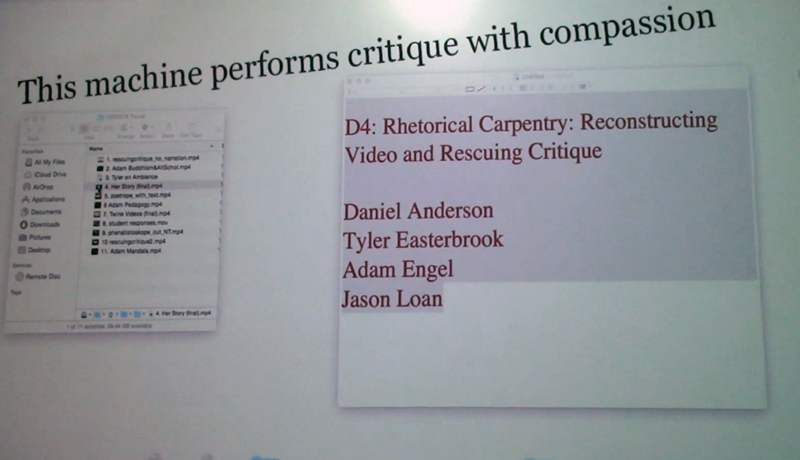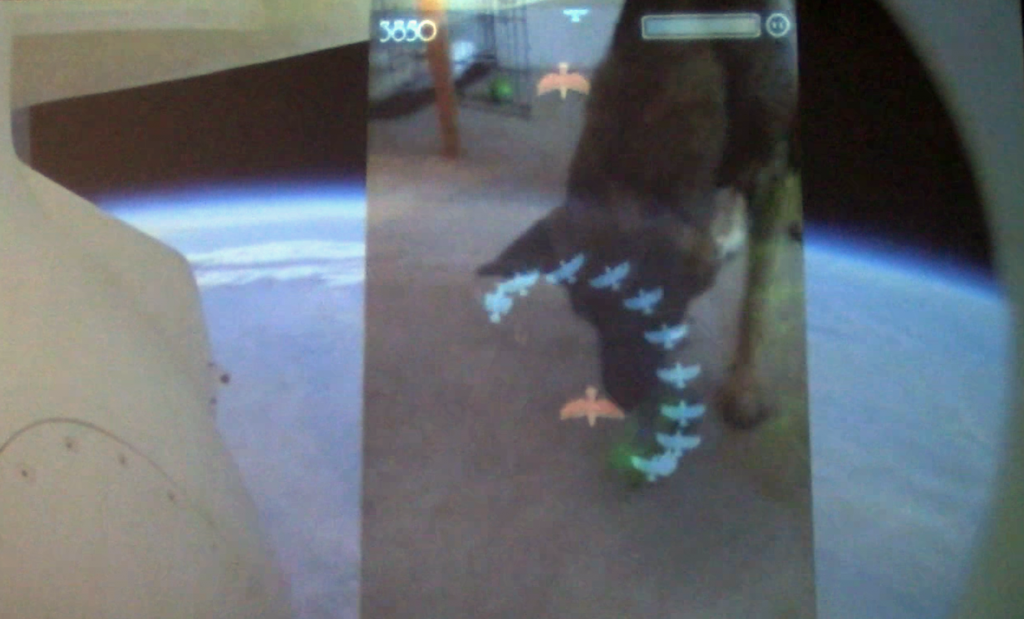D4: Rhetorical Carpentry: Reconstructing Video and Rescuing Critique
Presenters: Jason Loan, Tyler Easterbrook, Adam Engel, Daniel Anderson

This machine performs critique with compassion.
The SITES Lab crew from the University of North Carolina at Chapel Hill offered a carefully structured and well-documented series of short films that explore a variety of approaches to digital cinematography and critique. Extending their previous work on scholarly response, Jason Loan, Daniel Anderson, Adam Engel, and Tyler Easterbrook play with the flexibility and interactive possibilities of film as a means of discussing and enacting theory, commentary, and meditation.
The presenters described their film set as modular, created with the idea that the compositions could potentially be mixed and matched in any order while still providing valuable interactions and conversations among the set. We were seated in a dark roundtable room surrounded by three screens on which a series of eleven short films of alternating authorship were played one after another. Some were accompanied by narration, others had pre-recorded audio, and others included a hybrid of both. The mood was a cross between an open mic night and an art installation as the presentations moved from theoretical explanation to classroom demonstrations to theatrical performances.
Dan Anderson’s opening film invoked the problem to which much of the following work responds: the modes of critique valorized by the academy may be too limited, banal, and unappreciative of affect and generosity. Alt-scholarship offers options for generous appreciation, affective experience, and compositional mood. Anderson’s demonstration drew attention to the process of construction in a film that incorporates the layered work of others, including music, image, voice, and computer interface. The conversation was next picked up by Engel, whose first film (starring Dante the German Shepherd) addresses the loss incurred by reducing art to its interpretable content. Images of familiar embodied experiences played beneath a transparent overlay of a simple video game, juxtaposing sensual experience and digital play. Engel tossed this video game thread to Easterbrook, who read a reflection on procedural expression, digital composition, and gamic persuasion. Should games be forced to have a persuasive rhetoricity, or do we lose the ambient qualities of the medium by requiring this mode? Easterbrook uses a playthrough video of the game Her Story to highlight the ambient qualities of a gameplay experience. Loan pulled us back to the material reality of filmmaking, interface visibility, and the cogs behind process. He showed us the zoetrope as a means of incorporating the viewer or user into the filmic product in a tactile way (and handed out printed paper zoetropes for the audience to handle).
Shifting focus, Engel introduced us to kynecism, “dog philosophy,” which invites the creation of videos “not entirely divided from their objects, nor are they attached to rational language — they are impactful gestures.” He shared three student-made videos to demonstrate how this compositional mode can be useful in the classroom: “Within this cheekiness, compassion arises.” Continuing the discussion of classroom utility, Easterbrook displayed functions of the game design tool Twine that allow students to create simple ambient games that can model a familiar experience. The next exploration of student participation came from Anderson’s presentation of student responses and reflections on the process during which they became producers.
The focus changes to enactment. Loan introduces us to another tactile film “toy”: the phenatistoskope. Again, this object is handled by the viewer/user rather than by the author/composer. He demonstrated his own process of manufacture, attempting to recreate a historical object. Loan laments that even in this room, we are primarily watching and consuming, and he wants us to be involved, to be users of the media. Anderson offers a film drawing attention to the visceral experience of viewing drag races. His video includes a projection of a drag race onto his own body as he plays the guitar and sings, using his white shirt as the projection screen. Finally, Engel offers us a consideration of dhyana, a meditation mode, showing scenes of monastic practice and mandala crafting overlaid again with the playfulness of a beloved dog. We partake of the transience of art without splitting it for analysis. The success of the conversational and participatory mood of the panel was demonstrated the unreserved curiosity displayed by the audience during the discussion that followed.

